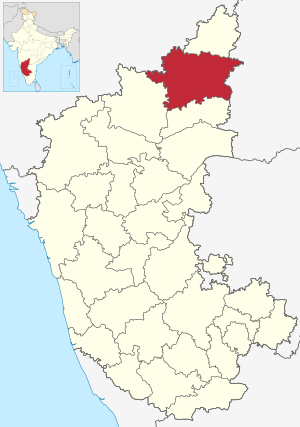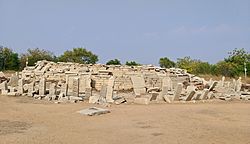Kalaburagi district facts for kids
Quick facts for kids
Kalaburagi district
Gulbarga district
|
|
|---|---|
|
Clockwise from top-left: Gulbarga Fort, Suryanarayana Temple in Kalgi, Panchlingeshwara Temple near Sedam, Ruins in Sannati, Mosque in Gulbarga city
|
|
| Nickname(s):
Land of Toor Dal
|
|

Location in Karnataka
|
|
| Country | |
| State | Karnataka |
| Region | Kalyana-Karnataka |
| Division | Kalaburagi Division |
| Headquarters | Kalaburagi |
| Government | |
| • Type | Karnataka state Government |
| • Body | Karnataka Legislative Assembly |
| Area
†
|
|
| • Total | 10,951 km2 (4,228 sq mi) |
| Elevation | 454 m (1,490 ft) |
| Population
(2011)†
|
|
| • Total | 2,566,326 |
| • Density | 234.346/km2 (606.954/sq mi) |
| Language | |
| • Official | Kannada, |
| Time zone | UTC+5:30 (IST) |
| PIN |
585101
585102 585103 |
| Telephone code | 91 8472 |
| Vehicle registration | KA-32 |
| No. of taluks | 11 |
| Lok Sabha constituency | Kalaburagi (Lok Sabha constituency) |
| Precipitation | 777 millimetres (30.6 in) |
| Avg. summer temperature | 42 °C (108 °F) |
| Avg. winter temperature | 26 °C (79 °F) |
| †website | |
Kalaburagi district, also known as Gulbarga district, is a region in the southern Indian state of Karnataka. The city of Kalaburagi is its main administrative center. This district is also the headquarters for the larger Kalaburagi division.
The district is located in north Karnataka. It covers an area of about 10,951 square kilometers. It shares borders with other districts and states. To the west are Bijapur and Solapur district in Maharashtra. To the north are Bidar district and Osmanabad district in Maharashtra. Yadgir district is to the south, and Sangareddy and Vikarabad in Telangana are to the east.
Contents
Exploring Kalaburagi's Past
The name Kala-buragi means "stony land" in the local Kannada language. This area has a long and interesting history. Many different rulers have controlled it over time.
Early Rulers and Dynasties
In the 6th century CE, the powerful Chalukyas ruled this district. Later, the Rashtrakutas took control for a short period. But the Chalukyas soon returned and ruled for another two centuries.
After them, the Kalachuris ruled until the 12th century. Then, the Yadavas took over. The Kakatiyas followed, ruling until 1324. Their kingdom then fell to the Delhi Sultanate.
Rise of the Bahmani Sultanate
Local governors had big plans and formed the Bahmani Sultanate. They made Kalaburagi their capital city. Over time, the Bahmani Sultanate broke into five smaller kingdoms called the Deccan Sultanates.
Kalaburagi was ruled by the Bidar Sultanate. In 1619, it became part of the Bijapur kingdom.
Mughal Rule and Modern Times
Soon, the district joined the huge Mughal Empire. However, the governors of the Deccan region, known as the Asaf Jahi, later formed their own Hyderabad State. Kalaburagi was part of this state.
Hyderabad became a princely state under British India. In 1948, it joined independent India. Kalaburagi, along with Bidar and Raichur, became part of Karnataka. This region is now known as Kalyana-Karnataka. This area has faced challenges and is working to catch up with other parts of the state.
Kalaburagi's Economy
In 2006, the government identified Kalaburagi as one of India's "most backward districts." This means it needed extra help for development.
It is one of five districts in Karnataka that receives special funding. This funding comes from the Backward Regions Grant Fund Programme (BRGF). This program helps improve living conditions and opportunities in these areas.
Interesting Places to Visit
Kalaburagi district has many historical and interesting sites.
Historical Landmarks
- Sannati: This small village is located by the Bhima River. It is famous for its ancient Ashokan edicts. These are messages carved in stone by Emperor Ashoka (who ruled from 274–232 BC). You can also find a Buddhist stupa here and a rare image of Emperor Ashoka himself.
- Manyakheta: This village is on the banks of the Kagina river. It used to be the capital city of the Rashtrakuta dynasty. Manyakheta is about 40 kilometers southeast of Kalaburagi city.
- Kalaburagi Fort: Built in 1347, this old fort has a moat around it. Even though it's quite old, it still has many interesting buildings inside.
- Jama Masjid: Inside the fort, you'll find the Jama Masjid. It is believed to have been built by an architect from Moorish Spain. This mosque is special in India because it has a huge dome covering the main area. It also has four smaller domes at the corners and 75 even smaller ones all around.
- Fort Towers: The fort itself has 15 towers.
- Haft Gumbaz: Near Kalaburagi, there are also impressive tombs of the Bahmani kings, known as Haft Gumbaz.
Geography of Kalaburagi
Kalaburagi is located on the Deccan Plateau. Its elevation ranges from 300 to 750 meters above sea level. The most important river flowing through the district is the Bhima.
Areas Within Kalaburagi
Kalaburagi district is divided into 11 smaller administrative areas called talukas. This happened after Yadgir district became a separate district.
- Kalaburagi
- Aland
- Afzalpur
- Jevargi
- Sedam
- Shahabad
- Kalgi
- Kamalapur
- Chitapur
- Chincholi
- Yedrami
People and Population
| Historical population | ||
|---|---|---|
| Year | Pop. | ±% p.a. |
| 1901 | 586,760 | — |
| 1911 | 640,851 | +0.89% |
| 1921 | 589,958 | −0.82% |
| 1931 | 658,151 | +1.10% |
| 1941 | 704,139 | +0.68% |
| 1951 | 806,394 | +1.37% |
| 1961 | 963,619 | +1.80% |
| 1971 | 1,208,007 | +2.29% |
| 1981 | 1,442,258 | +1.79% |
| 1991 | 1,786,138 | +2.16% |
| 2001 | 2,174,742 | +1.99% |
| 2011 | 2,566,326 | +1.67% |
| source: | ||
| Religion in Kalaburagi district (2011) | ||||
|---|---|---|---|---|
| Hinduism | 78.36% | |||
| Islam | 19.99% | |||
| Other or not stated | 1.65% | |||
According to the 2011 census, Kalaburagi district has a population of about 2.5 million people. This number is similar to the population of the country of Kuwait. The district ranks 162nd in population among all 640 districts in India.
The population density is about 233 people per square kilometer. Between 2001 and 2011, the population grew by about 17.94%. For every 1000 males, there are 971 females. The literacy rate, which is the percentage of people who can read and write, is 64.85%. About 32.56% of the people live in cities.
Languages Spoken in Kalaburagi
Many different languages are spoken in Kalaburagi district. In 2011, the most common first language was Kannada, spoken by 65.70% of the population. Other languages include Urdu (18.15%), Lambadi (7.09%), Telugu (4.08%), Marathi (2.47%), and Hindi (2.05%).
See also
 In Spanish: Distrito de Gulbarga para niños
In Spanish: Distrito de Gulbarga para niños
- Yadgir (Lok Sabha constituency)
- Kalaburagi (Lok Sabha constituency)






